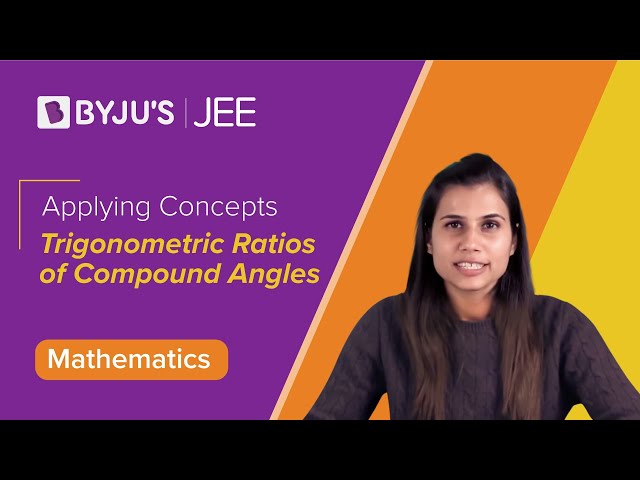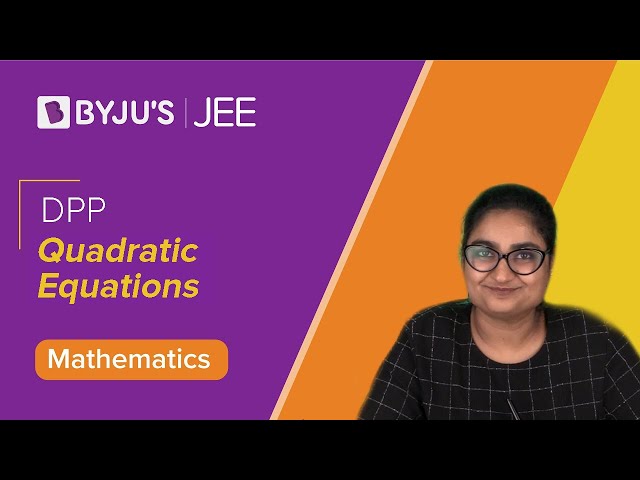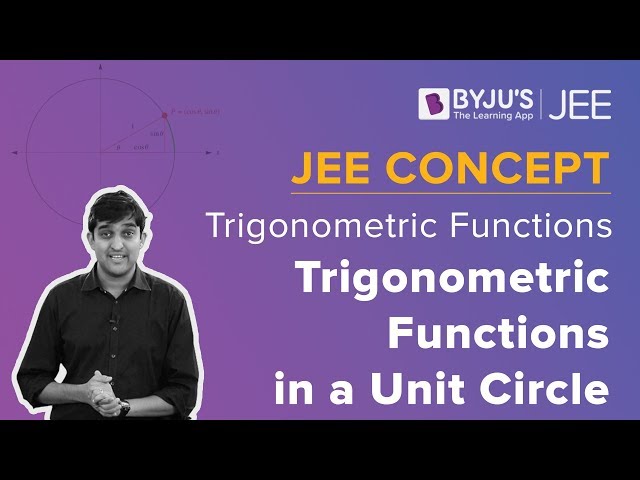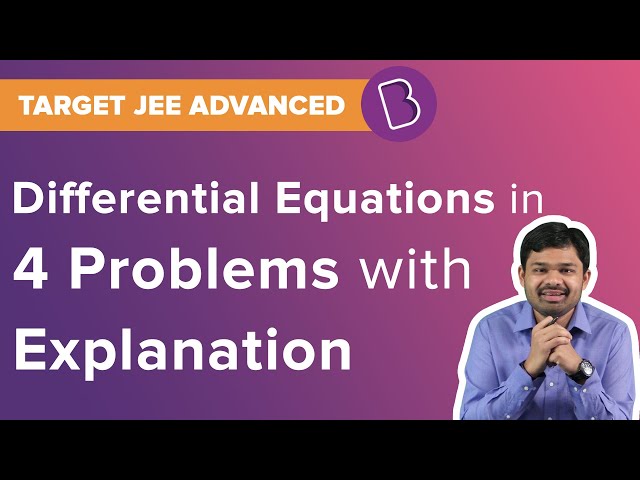JEE Main 2020 Maths Paper With Solutions Shift 2 September 4
1. Suppose the vectors x1, x2 and x3 are the solutions of the system of linear equations, Ax = b when the vector b on the right side is equal to b1, b2 and b3 respectively. If x1 =
a) 2
b) 1/2
c) 3/2
d) 4
Using AX = B
A =
a1+a2+a3 = 1
a4+a5+a6 = 0
a7+a8+a9 = 0
2a2+a3 = 0
2a5+a6 = 2
2a8+a9 = 0
a3 = 0, a6 = 0, a9 = 2
a8 = -1
a5 = 1
a2 = 0
⇒ a1 = 1
a4 = -1
a7 = -1
A =
A = 2×1 = 2
Answer: a
2. If a and b are real numbers such that (2+α)4 = a+bα, where α = (-1+i√3)/2 then a+b is equal to:
a) 33
b) 57
c) 9
d) 24
(2+α)4 = a+bα
(2+(-1+i√3)/2)4 = a+bα

b√3/2 = 9√3/2
⇒ b = 9
a = 0
a+b = 9
Answer: c
3. The distance of the point (1, -2, 3) from the plane x-y+z = 5 measured parallel to the line (x/2) = (y/3) = (z/-6) is:
a) 1/7
b) 7
c) 7/5
d) 1
Equation of line through (1,-2,3) whose d.r.s. are (2,3,-6)
(x-1)/2 = (y+2)/3 = (z-3)/-6 = λ
Any point on the line (2λ+1, 3λ-2, -6λ+3)
Put in (x-y+z = 5)
2λ+1- 3λ+2-6λ+3 = 5
-7λ = -1
λ = 1/7
Distance = √((2λ)2+(3λ)2+(6λ)2)
= √(4λ2+9λ2+36λ2)
= 7λ
= 1 unit
Answer: d
4. Let f: (0, ∞)→ (0, ∞) be a differentiable function such that f(1) = e and
a) e
b) 2e
c) 1/e
d) 1/2e
f(1) = e ..(i)
L’ Hospital rule
⇒ limt→x (2tf2(x)-2x2f(t).f’(t)) = 0
⇒ 2xf2(x)-2x2f(x).f’(x) = 0
⇒ 2xf(x){f(x)-xf’(x)} = 0
⇒ f’(x)/f(x) = 1/x
ln f(x) = ln x+ln c
⇒ f(x) = cx ..(ii)
If x = 1
f(1) = c(1)
f(1) = c
From equation (i) and (ii)
c = e ..(iii)
From (iii)
f(x) = ex
⇒ y = ex or y = cx
if f(x) = 1
⇒ x = 1/e
Answer: c
5. Contrapositive of the statement :
‘If a function f is differentiable at a, then it is also continuous at a’, is:
a) If a function f is not continuous at a, then it is not differentiable at a.
b) If a function f is continuous at a, then it is differentiable at a.
c) If a function f is continuous at a, then it is not differentiable at a.
d) If a function f is not continuous at a, then it is differentiable at a.
Contrapositive of p → q = ∼q → ∼p
Answer: a
6. The minimum value of 2sinx+2cosx is:
a) 21-√2
b) 21-1/√2
c) 2-1+√2
d) 2-1+1/√2
Using A.M. ≥ G.M.
y = 2sinx+2cosx
(2sinx+2cosx)/2 ≥ √(2sinx+cosx)
2sinx+cosx ≥ 21×2(sinx+cosx)/2
2sinx+cosx ≥ 2(2+sinx+cosx)/2
⇒ (2sin x+2cos x)minimum = 2(2-√2)/2
= 21-1/√2
Answer: b
7. If the perpendicular bisector of the line segment joining the points P(1 ,4) and Q(k, 3) has y-intercept equal to -4, then a value of k is:
a) -2
b) √15
c) √14
d) -4
mPQ = (4-3)/(1-k)
⇒
Midpoint of PQ = ((k+1)/2, 7/2)
equation of perpendicular bisector
y-7/2 = (k-1)(x-(k+1)/2)
for y intercept put x = 0
y = (7/2)-(k2-1)/2 = -4
(k2-1)/2 = 15/2
⇒ k = 4 and k = -4
Answer: d
8. The area (in sq. units) of the largest rectangle ABCD whose vertices A and B lie on the x-axis and vertices C and D lie on the parabola, y = x2-1 below the x-axis, is:
a) 2/3√3
b) 4/3
c) 1/3√3
d) 4/3√3

Area = 2a(a2-1)
A = 2a3-2a
dA/da = 6a2-2 = 0
d2A/da2 = 12a
at a = -1/√3
d2A/da2 = -4√3 <0
So area is maximum at a = -1/√3
Amax = (-2/3√3)+(2/√3)
= (-2+6)/3√3
= 4/3√3 sq. units
Answer: d
9. The integral
a) 9/2
b) -1/18
c) -1/9
d) 7/18

= (1/2)[9×0-(1/3)×(1/3)×1]
= -1/18
Answer: b
10. If the system of equations
x+y+z = 2
2x+4y–z = 6
3x+2y+ λz = μ
has infinitely many solutions, then
a) λ-2μ = -5
b) 2λ+μ = 14
c) λ+2μ = 14
d) 2λ-μ = 5
D = 0
⇒
(4λ+2)-1(2λ+3)+1(4-12) = 0
4λ+2-2λ-3-8 = 0
2λ = 9
⇒ λ = 9/2
Dx =
⇒ μ = 5
Now check option
2λ+μ = 14
Answer: b
11. In a game two players A and B take turns in throwing a pair of fair dice starting with player A and total of scores on the two dice, in each throw is noted. A wins the game if he throws a total of 6 before B throws a total of 7 and B wins the game if he throws a total of 7 before A throws a total of six The game stops as soon as either of the players wins. The probability of A winning the game is :
a) 5/31
b) 31/61
c) 30/61
d) 5/6
sum total 7 = {(1,6)(2,5)(3,4)(4,3)(5,2)(6,1)}
P(sum 7) = 6/36
sum total 6 = {(1,5)(2,4)(3,3)(4,2)(5,1)}
P(sum 6) = 5/36
P(Awin) =
= (5/36)+(31/36)×(30/36)×(5/36)+…
= (5/36)÷(1-(31×30)/(36×36)
= (5×36)/(36×36-31×30)
= 5×36/366
= 30/61
Answer: c
12. If for some positive integer n, the coefficients of three consecutive terms in the binomial expansion of (1+x)n+5 are in the ratio 5:10:14, then the largest coefficient in this expansion is :
a) 792
b) 252
c) 462
d) 330
Tr:Tr+1:Tr+2
n+5Cr-1: n+5Cr: n+5Cr+1 = 5:10:14
(n+5)!/(r-1)!(n+6-r)! : (n+5)!/r!(n+5-r)! = 5/10
r/(n+6-r) = 1/2
(r+1)!(n+4-r)!/r!(n+5-r)! = 5/7
2r = n+6-r
3r = n+6 ..(i)
(r+1)/(n+5-r) = 5/7
7r+7 = 5n + 25-5r
12r = 5n+18 ..(ii)
From eq.(i) and (ii)
4(n+6) = 5n+18
n = 6, r = 4
Then we can find (1+x)11
Largest coefficient in the expansion (1+x)11 = 11C6 = 462
Answer: c
13. The function 
a) both continuous and differentiable on R-{-1}
b) continuous on R-{-1} and differentiable on R-{-1,1}
c) continuous on R-{1} and differentiable on R-{-1,1}
d) both continuous and differentiable on R-{1}

At x = 1, f(1) = π/2
f(1+) = 0
discontinuous ⇒ non diff.
At x = -1
f(-1) = 0
f(-1–) = (1/2){+1-1} = 0
cont. at x = -1

At x = -1, f’(-1) = -1/2
And f’(-1+) = 1/2
So, at x = -1 it is non differentiable.
Answer: c
14. The solution of the differential equation (dy/dx)-((y+3x)/loge(y+3x)) + 3 = 0 is: (where c is a constant of integration)
a) x-loge(y+3x) = C
b) x-(1/2)(loge(y+3x))2 = C
c) x-2loge(y+3x) = C
d) y+3x-(1/2)(logex)2 = C
(dy/dx)-((y+3x)/ln(y+3x))+3 = 0
⇒ (dy/dx)+3 = (y+3x)/ln(y+3x)
Let ln(y + 3x) = t
(1/y+3x)×((dy/dx)+3) = dt/dx
(y+3x)dt/dx = (y+3x)/t
⇒ tdt = dx
t2/2 = x+C
(1/2)(ln(y+3x))2 = x+C
Answer: b
15. Let λ ≠ 0 be in R. If α and β are the roots of the equation, x2-x+2λ = 0 and α and γ are the roots of the equation, 3x2-10x+27λ = 0, then βγ/λ is equal to:
a) 27
b) 9
c) 18
d) 36
x2-x+2λ = 0 (α, β) ..(i)
3x2-10x+27λ = 0 (α, γ) ..(ii)
Multiply (i) by 3
3x2-3x+6λ = 0 ..(iii)
Equation (ii)-(iii)
-7x+21λ = 0
α = 3λ
Put in equation (i)
9λ2-3λ+2λ = 0
9λ2-λ = 0
⇒ λ = 1/9
⇒ α = 1/3
αβ = 2/9
⇒ β = 2/3
αγ = 1
⇒ γ = 3
βγ/λ ⇒ (2/3)×3÷1/9
= 18
Answer: c
16. The angle of elevation of a cloud C from a point P, 200 m above a still lake is 300. If the angle of depression of the image of C in the lake from the point P is 600, then PC (in m) is equal to :
a) 200√3
b) 400√3
c) 400
d) 100

(h-200)/x = tan 300
(h+200)/x = tan 600
(h+200)/(h-200) = 3
h+200 = 3h-600
2h = 800
h = 400
(h-200)/PC = sin 300
PC = 400 m
Answer: c
17. Let
a) 15
b) 30
c) 50
d) 45
Number of elements of set T =
⇒ 50×10/20 = n×5/6
⇒ (50/2)×(6/5) = n
⇒ n = 30
Answer: b
18. Let x = 4 be a directrix to an ellipse whose centre is at the origin and its eccentricity is 1/2. If P(1, β ), β> 0 is a point on this ellipse, then the equation of the normal to it at P is :
a) 8x-2y = 5
b) 4x-2y = 1
c) 7x-4y = 1
d) 4x-3y = 2
e = 1/2
x = a/e = 4
⇒ a = 2
e2 = 1-b2/a2
⇒ 1/4 = 1-(b2/4)
(b2/4) = 3/4
⇒ b2 = 3
Elipse (x2/4)+(y2/3) =1
P(1,β)
x = 1
(1/4)+(β2/3) = 1
β2/3 = 3/4
⇒ β = 3/2
⇒ P(1, 3/2)
Equation of normal (a2x/x1)-(b2y/y1) = a2-b2
(4x/1)-(3y/3/2) = 4-3
4x-2y = 1
Answer: b
19. Let a1, a2, …, an be a given A.P. whose common difference is an integer and Sn = a1+a2+ …. +an. If a1 = 1, an = 300 and 15 ≤ n ≤ 50, then the ordered pair (Sn-4, an-4) is equal to:
a) (2480,248)
b) (2480,249)
c) (2490,249)
d) (2490,248)
a1 = 1, an = 300, 15≤ n ≤50
300 = 1+(n-1)d
(n-1) = 299/d
n-1 = integer, d has to be a factor of 299.
So, d = 23 or 13
if d = 23
then n-1 = 13
n = 14 (reject)
or d = 13
n-1 = 23
n = 24 is possible (15 ≤ n <50)
Or S20 = (20/2){2+19×13}
= 10×249
= 2490
a20 = 1+19×13
= 248
(S20, a20) = (2490, 248)
Answer: d
20. The circle passing through the intersection of the circles, x2+y2-6x = 0 and x2+y2-4y = 0, having its centre on the line, 2x-3y+12 = 0, also passes through the point:
a) (-1,3)
b) (1,-3)
c) (-3,6)
d) (-3,1)
S1+λ(S1-S2) = 0
x2 + y2-6x+λ(4y-6x) = 0
x2+y2-6x(1+ λ)+4λy = 0
Centre (3(1+λ ), -2λ) put in 2x-3y+12 = 0
6+6λ+6λ+12 = 0
12λ = -18
λ = -3/2
Circle is x2+y2+3x-6y = 0
Check options
(-3,6) is the point.
Answer: c
21. Let {x} and [x] denote the fractional part of x and the greatest integer ≤ x respectively of a real number x. If
=
= n/2
⇒ 1+2+…n-1 = n(n-1)/2
⇒ n/2, n(n-1)/2, 10(n2-n) → G.P
⇒ n2(n-1)2/4 = (n/2)×10×n×(n-1)
⇒ n-1 = 20
⇒ n = 21
Answer: 21
22. A test consists of 6 multiple choice questions, each having 4 alternative answers of which only one is correct. The number of ways, in which a candidate answers all six questions such that exactly four of the answers are correct, is
6C4×1×32 = 15×9 = 135
Answer: 135
23. If
=
= 1+4
= 5
Similarly
= 8
= 5
⇒ 5+8+5 = 18
Answer: 18
24. Let PQ be a diameter of the circle x2+y2 = 9. If α and β are the lengths of the perpendiculars from P and Q on the straight line, x+y = 2 respectively, then the maximum value of αβ is:

α =
β =
αβ =
⇒ αβ =
⇒ αβ =
αβmax = (9+5)/2
= 7
Answer: 7
25. If the variance of the following frequency distribution :
|
Class |
10-20 |
20-30 |
30-40 |
|
Frequency |
2 |
x |
2 |
is 50, then x is equal to

400/(4+x) = 50
x = 4
Answer: 4
Video Lessons – September 4 Shift 2 Maths




Comments